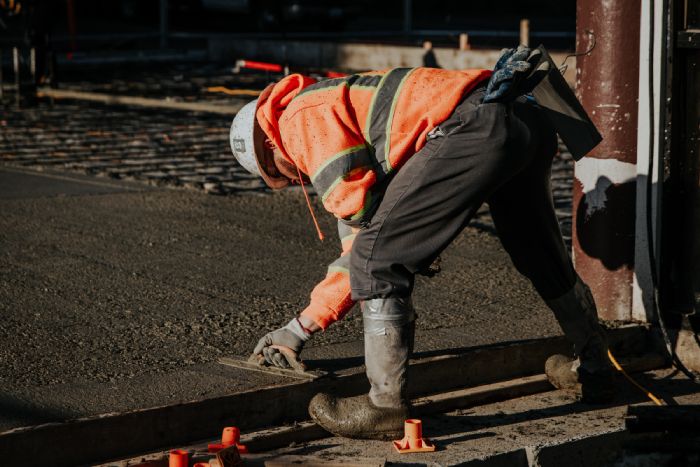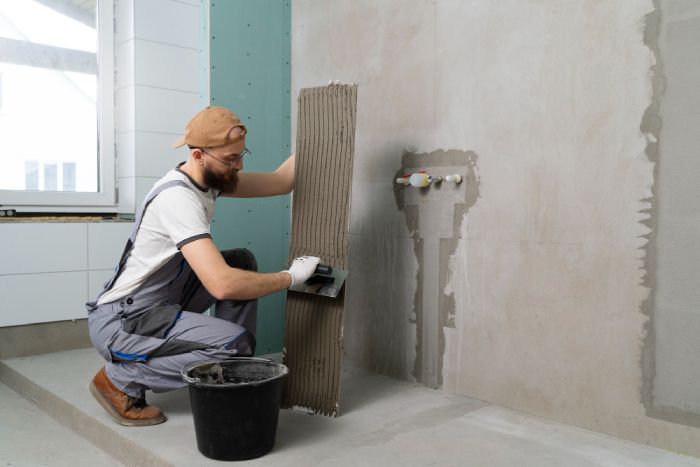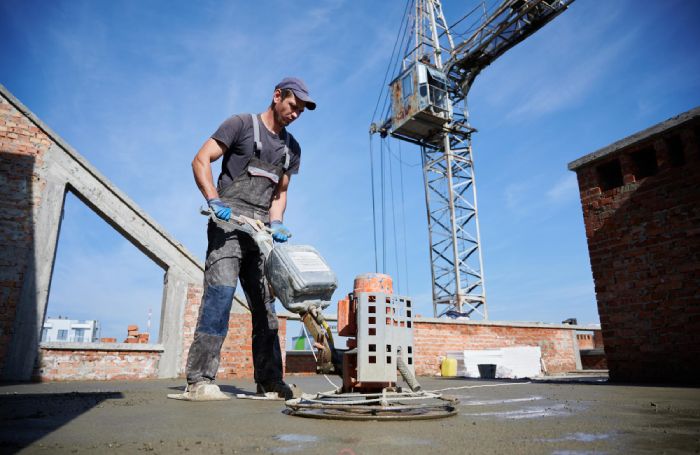Have you ever wondered if an epoxy kitchen floor could handle a family’s kitchen’s daily wear and tear? It is one of the most important questions when considering what type of flooring to install in your home. With the hustle and bustle of everyday life, the kitchen floor endures constant foot traffic, spills, and dropped utensils. Fortunately, epoxy flooring has gained popularity recently due to its durability and resistance to dirt, scratches, and chemicals.
In this article, you’ll discover the capabilities of epoxy kitchen floors and determine whether they are up to the task of withstanding the demands of a busy household.
Benefits of Epoxy Flooring in a Kitchen Environment
Epoxy flooring in a kitchen environment offers numerous benefits, making it a popular choice for homeowners. Here is a range of the valuable strengths:
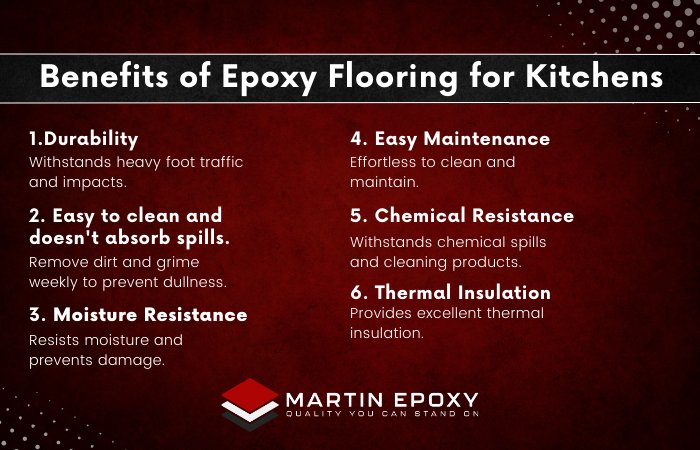
- Durability: Epoxy flooring is highly durable and can withstand heavy foot traffic, dropped utensils, and other impacts commonly experienced in a kitchen. It is resistant to scratching, chipping, and general wear and tear, ensuring that your kitchen floor maintains its attractive appearance for a long time.
- Stain Resistance: Kitchens are prone to spills and stains, especially from food and beverages. Epoxy flooring is non-porous and doesn’t absorb liquids or stains easily. This property makes cleaning and maintenance much easier, as spills can be quickly wiped away without leaving permanent marks or stains on the epoxy kitchen floor.
- Moisture Resistance: Kitchens are often exposed to moisture from cooking, washing dishes, and other activities. Epoxy flooring creates a seamless and impervious surface that resists moisture, preventing it from seeping into the flooring material and causing damage. It is also resistant to mold and mildew growth, ensuring a hygienic kitchen environment.
- Easy Maintenance: Epoxy floors are effortless to clean and maintain. Regular sweeping or mopping is sufficient to keep the floor clean and debris-free. Its smooth and glossy surface prevents dirt and grime from sticking, making it effortless to maintain the cleanliness and hygiene of your kitchen floor.
- Chemical Resistance: Epoxy flooring demonstrates exceptional resistance to a wide range of chemicals, including everyday kitchen cleaning products, ensuring that the epoxy kitchen floor remains unaffected by chemical spills or cleaning procedures.
- Thermal Insulation: Epoxy flooring provides excellent thermal insulation, which can help keep your kitchen and home cooler during the hot summer months. It prevents the floor from becoming excessively warm. It can contribute to energy efficiency by reducing the need for air conditioning.
Overall, epoxy flooring provides a practical and aesthetically pleasing solution for kitchens. Its durability, resistance to stains and moisture, low maintenance requirements, and design versatility make it an ideal choice for homeowners seeking a reliable, long-lasting flooring option.
Preparation Steps for Installing an Epoxy Floor
Preparing the surface for an epoxy kitchen floor is essential to achieving a durable and long-lasting finish. Installing an epoxy floor requires special preparation steps that must be followed for optimal results. Here are the preparation steps for installing an epoxy floor:

- Clean and Remove Debris: Thoroughly clean the surface to remove all dirt, dust, grease, oil, paint, or other substances. Use a degreaser or suitable cleaner to ensure a clean surface.
- Repair Cracks and Divots: Fill in any cracks or divots in the existing flooring material. Use a suitable epoxy filler or patching compound to level out the surface. Allow the repairs to dry and cure completely before proceeding.
- Sand the Surface: Sand the substrate using coarse grit sandpaper to create a rough texture. This roughness provides a better bonding surface for the epoxy. Vacuum or sweep up any dust created during the sanding process to ensure a clean surface.
- Apply Primer: Apply a primer coat to the sanded surface. The primer serves as a basecoat, enhancing adhesion between the substrate and the epoxy. Follow the manufacturer’s guidelines for proper application and drying time.
- Apply Epoxy Coating: Once the primer has dried, apply the epoxy coating according to the manufacturer’s instructions. Use a roller or brush to apply the epoxy evenly, and ensure that each layer is given enough time to cure before applying additional coats. Follow the recommended curing time for the specific epoxy product being used.
Remember to consult the specific instructions supplied by the manufacturer for the product you are using for your epoxy kitchen floor, as different products may have slightly different preparation and application requirements.
Proper Maintenance and Cleaning Techniques
Proper maintenance and cleaning techniques are crucial for preserving the beauty and functionality of epoxy kitchen floors. Here are some guidelines to follow:
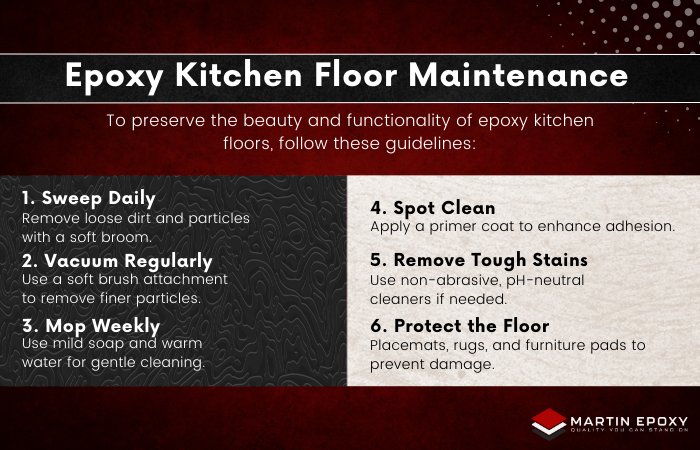
- Sweep Daily
Use a soft-bristle broom or a debris mop to remove loose dirt, dust, and particles from the surface. Regular sweeping prevents the accumulation of dirt that can scratch the epoxy coating.
- Vacuum Regularly
Use a vacuum device with a soft brush attachment for more thorough cleaning. It helps remove finer particles and ensures that the floor remains clean without causing any damage.
- Mop Weekly
Prepare a solution of warm water and a mild soap or detergent recommended explicitly for epoxy kitchen floors. Avoid strong chemicals or abrasive cleaners, which can damage the epoxy coating. Dip a mop or microfiber towel into the solution, wring it out well, and clean the floor gently. Rinse the mop or cloth frequently to avoid spreading dirt or residue.
- Spot Clean as Needed
For spills or stains, attend to them promptly. Use a smooth cloth or sponge with soap to clean the affected area gently. Avoid scrubbing vigorously or using rough materials that could scratch the surface.
- Remove Tough Stains
If there are stubborn stains that cannot be removed with regular cleaning, you can use a non-abrasive, pH-neutral cleaner or a specialized epoxy kitchen floor cleaner. Follow the manufacturer’s instructions for application and rinse the epoxy kitchen floor thoroughly afterward.
- Protect the Floor
Place mats or rugs at entryways and high-traffic areas to trap dirt and prevent it from being tracked onto the epoxy floor. Use pads or felt protectors under heavy furniture to avoid scratching or denting the surface.
By following these maintenance and cleaning techniques, you can keep your epoxy kitchen floor looking its best and prolong its lifespan, ensuring it remains durable and functional for years.
Durability and Strength of Epoxy Flooring
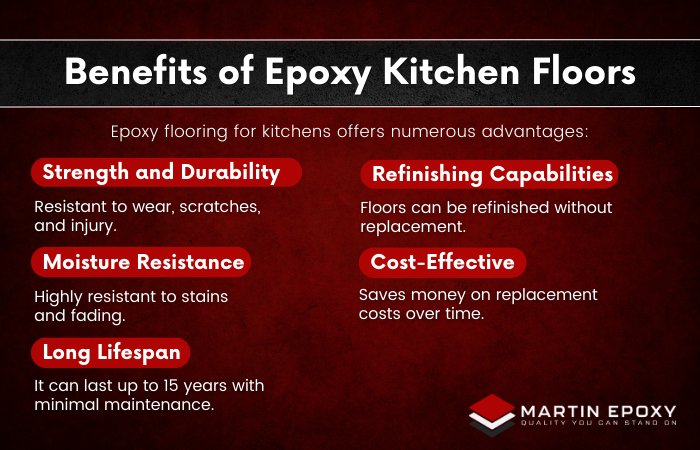
Epoxy flooring is renowned for its strength and durability, making it an ideal option for kitchen floors. Its strong surface can withstand the wear and tear of everyday use, giving your kitchen long-term protection from scratches, dents, spills, and other damage. Epoxy’s resistance to moisture also makes it highly resistant to staining or fading over time.
When installed correctly by a professional installer using high-quality products, an epoxy kitchen floor should last up to 15 years with minimal maintenance required. It means that you won’t need to worry about replacement costs anytime soon due to normal usage wear and tear. In addition, epoxy floors can be refinished as needed throughout their lifespan without replacing the entire floor – saving both time and money in the long run.
Overall, epoxy is one of the strongest and most durable choices regarding kitchen flooring options, making it an excellent investment for homeowners looking for long-lasting solutions. Epoxy kitchen floor installations’ durability ensures they can endure the daily wear and tear caused by foot traffic, dropped utensils, spills, and other activities.
Cost-Effectiveness of Epoxy Floors
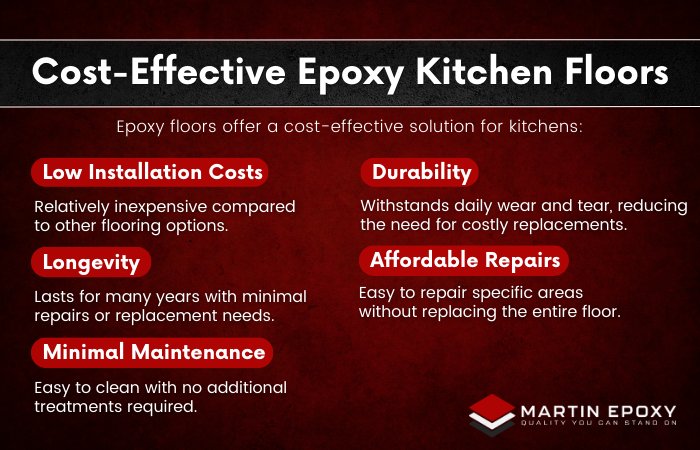
Epoxy floors are an incredibly cost-effective option for kitchen flooring. The installation costs are relatively low compared to other types of flooring, and the longevity of epoxy is well known; it can last for many years before needing repairs or replacement. In addition, maintenance costs are also minimal with epoxy; the surface is easy to clean and requires no additional treatments over time to remain intact.
Overall, when looking at initial installation and ongoing maintenance costs, opting for an epoxy floor will save you money in the long run. Not only that, but the durability of this type of floor ensures that your investment will be protected from daily wear and tear. Furthermore, should any damage occur to the surface due to heavy foot traffic or spilled ingredients, it’s a simple task to repair these areas without having to replace the entire floor.
In short, choosing an epoxy kitchen floor allows homeowners to enjoy all the benefits of a durable material while reaping savings on their monthly budget. It makes it one of the most attractive options for anyone looking for an economical yet reliable solution for their home’s kitchen area.
Epoxy Kitchen Floor Final Thoughts

An epoxy kitchen floor is a smart choice when considering how best to handle everyday wear and tear in your cooking area. It offers tremendous benefits – from cost savings over traditional tile floors to enhanced visual appeal – while maintaining high durability and strength. With all its advantages, an epoxy floor is an excellent investment that will pay off time and again. You won’t have to worry about replacing or repairing it soon.
At Martin Epoxy, we offer exceptional epoxy flooring solutions for your kitchen. Experience the benefits of durability, cost-effectiveness, and visual appeal. Don’t wait any longer—contact us today and transform your kitchen with an epoxy floor!


